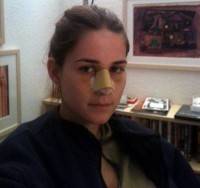Recovery Time For Rhinoplasty And Deviated Septum Surgery
In my practice, we remove the splint from the nose at 7 days. Most people go back to work by 8-10 days after surgery, depending on bruising.
Everybody bruises differently. I have attached a link that goes into the details. (Stuart H. Bentkover, MD, Boston Facial Plastic Surgeon)
When can I go out in public after rhinoplasty?
Most people considering rhinoplasty want to know the answer to two questions. When will I be able to go out in public?
And, when will I see the change I am looking for? The first answer is easy. Within one week after surgery, bruising and ‘social’ swelling should be essentially gone.
After one week, most every patient is comfortable returning to work or school and seeing people socially. That being said, your nose will not feel to you to be entirely normal yet.
It may be a little numb and stiff, and your smile may feel tight or awkward. But, this should not really be noticeable to anyone else.
Most patients tell us that no one noticed anything different unless they had told others they were having surgery. On the second question, you should be seeing noticeable improvement in your nose even within a week or two after surgery.
But, it will take some time before your nose starts to look like the imaged or imagined result. We are talking here about detail or refinement.
The skin has been lifted and changes made to cartilage and bone, and it takes months for the skin to contract and show detail.
Some factors can affect this timing although there is a fair bit of individual variation depending on the extensiveness of surgery. Thicker skin in general takes longer to contract.
Surgery in which the nose was made smaller will take some more time for skin to shrink down to the new level. Revisions can sometimes be slower to heal although not always.
If a large amount of scar was taken out during a revision and cartilage resupported, the skin will likely be able to drape better more quickly. Some patients look like their imaged photos after 3 months. Others may have some fluctuating puffiness and continued improvement well over a year or longer after surgery.
Things can be done along the way to help swelling go down as quickly as possible. It’s best to talk to your surgeon to get a sense of your expected course of healing. (Jason Litner, MD, Beverly Hills Facial Plastic Surgeon)
There are many stages to the recovery process after rhinoplasty surgery.
- Most of the bruising and swelling dissipates in the first week. This is typically when most surgeons remove the external splint. I will typically replace the hard splint with flesh tone steritapes which stay on for another week.
- 3-4 weeks is usually when most surgeons will allow rhinoplasty patients to exercise but restrict the patients from contact sports up to 6 weeks post op.
- Swelling and unnatural firmness will continue to resolve for anywhere between 9 months and a year after surgery. Most of this is not noticeable to the untrained eye. (Michael A. Epstein, MD, Chicago Plastic Surgeon)
Rhinoplasty recovery is predictable
For the most part, all sutures and splints will be removed one week after your rhinoplasty.
You can expect swelling to subside in the following pattern:
- Upper third of your nose: by about 3 months
- Middle third of your nose: by about 6 months
- Lower third of your nose: between 9 and 12 months. (Kevin Brenner, MD, FACS, Beverly Hills Plastic Surgeon)
Rhinoplasty Recovery Time and Downtime
At our office the splint comes out on the 4th day the recovery is fast and you can be in public 7-10 days after surgery. You will see the final result of your Rhinoplast result in a year. (Jhonny Salomon, MD, Miami Plastic Surgeon)
There is a one week, short term, recovery for Rhinoplasty surgery. A nasal splint is placed on the outside of the nose and is removed at the one week mark.
There also may be mild bruising during this time frame as well. Final results require one year to see the finished product due to swelling. (Edward J. Gross, MD, Orlando Facial Plastic Surgeon)
Rhinoplasty recovery time
On average, rhinoplasty patients take anywhere from 1-4 weeks to look acceptable. A lot of this is related to bruising around the eyes.
The splint usually comes off in 1 week. Sutures are usually removed in 3-7 days. (Kurtis Martin, MD, Cincinnati Plastic Surgeon)
Recovery time after a nose job
As with all plastic surgery procedures recovery time is in part defined by the individual. In general, most patients want to be able to go out and not have anyone think they have had surgery.
This timeframe varies on the type of rhinoplasty performed but is usually 2 weeks. By that time the splint and suture has been removed, makeup can be worn, some of the swelling has gone down and hopefully most of the bruising has gone away. (Remus Repta, MD, Scottsdale Plastic Surgeon)
Healing Following Rhinoplasty Varies From Person to Person; On Average, The Patient Is Able to Return To Work After 1 Week
Normally, the splint applied to the nose after rhinoplasty comes off in about one week. Sometimes there are some external stitches found at the base of the nose. These also are normally removed at approximately one week. Usually, at one week a person should be able to go out in public. Everyone is different however, and some patients may remain bruised or swollen longer than others. (John J. Edney, MD, Omaha Plastic Surgeon)
Rhinoplasty Recovery Timetable
Recovery time from rhinoplasty varies depending several factors
- Whether or not the bones have been fractured. In the typical patient, bruising that results from the in-fracturing of the nasal bones resolves in under a week. If the bones have been previously fractured either by surgery or trauma, the bruising may last slightly longer ~ 7- 10 days.
- Nasal skin thickness often determines how quickly noticeable swelling resolves. By the end of the week, the swelling of the nose and face has generally resolved to the point of being presentable in public. My rough rule of thumb is that 80% of swelling has resolved by 3-4 weeks; 90% at 90 days and the last 10% can take upwards of one year to resolve. When a patient has thick nasal skin, the swelling will persist quite a bit longer. Even with thick skin, the swelling will be reduced by 75% by the end of 90 days.
- Preop and postop care regimens will assist in minimizing swelling and accelerating the decrease in swelling. I place patients on Arnica Montana and Bromelain prior to surgery and have them continue after surgery. After surgery, the patient sleeps with their head elevated and apply cold compresses. After one week and the cast has been removed, I will have the patient tape the area just above the tip at night. The taping, in my opinion, greatly accelerated the reduction on swelling.
- Surgical technique: open has more swelling than closed rhinoplasty approach. Primary versus revision rhinoplasty. Revision rhinoplasty will typically have more swelling. (George T. Moynihan, MD, Chicago Facial Plastic Surgeon)
Recovery Following Rhinoplasty Can Take Up To 6 Weeks As It Involves A Specific Healing Process
The recovery time for rhinoplasty surgery varies depending on the exact details of the surgery that you need.
If it is just the tip that needs some alteration, the recuperation is shorter than if you need correction of the upper portions of the nose with breaking of the bones or work on the septum to improve breathing.
These more involved surgeries cause the swelling to stick around longer and may require more time with packing in the nose or a protective splint.
A rhinoplasty surgery is typically done with a general anesthetic (so you are all the way asleep) and done as an outpatient surgery (so you can go home that same day).
On average, most patients will wake up with packing in the nose that can come out on day one or two postoperatively. After surgery, while the packing is in, you cannot breath through your nose or blow your nose.
You also typically will have a plastic or plaster splint on the top of the nose that helps to prevent swelling and protects the nose from external pressure or injury.
This typically needs to remain on for at least one week (seldom longer than that). Obviously, while this is on you will feel socially unacceptable and probably will want to avoid going out in public, even though you will start to feel relatively good by the end of that week.
People usually only require pain medications for the first few days after a rhinoplasty, so you will most likely be able to drive yourself to your one week appointment where the splint is removed and some of the stitches are taken out.
Once the splint is removed, most people feel confident enough to go back to work and be seen in public, but there still is some swelling that will continue to go down over the next few weeks, and even some subtle changes that will continue to occur over the first year after rhinoplasty.
You will need to avoid heavy lifting and vigorous exercise for approximately three to four weeks after rhinoplasty and contact sports for six weeks if the bones have to be broken with the procedure.
For the specifics of what your rhinoplasty surgery would require, it is best to consult with a board certified plastic surgeon.
Board certification in plastic surgery guarantees that your surgeon has the education necessary to counsel you on your options and help you achieve your goals with your cosmetic procedure. (Marie E. Montag, MD, Omaha Plastic Surgeon)
Rhinoplasty Recovery Time
Typically, bandages and splints can come off within five to seven days after your surgery. Swelling and pain can be lessened with medication or using cold compresses and this will help with inflammation. Depending on how you are healing, it may take between several days or weeks before you can resume full activity. (Carlo Honrado, MD, FACS, Los Angeles Facial Plastic Surgeon)
Recovery time after rhinoplasty
The recovery time for rhinoplasty surgery is dependent on many factors, the most important being whether you need an open vs closed rhinoplasty. The amount of “tip work” and nasal bone fracturing that is required. The external splints usually stay on for 7-10 days. Internal splints usually stay in for 2-4 days, if you need a septoplasty or turbinate reduction. At 2 weeks you are ready for social interactions as most of the bruising has resolved. You will remain swollen, especially at the tip for several months but only you and your PS will notice this. (Pouria Moradi, MBBS, FRACS, Sydney Plastic Surgeon)
Rhinoplasty Recovery
One week is a good estimation for the amount of time you need to heal before going out in public with little signs of surgery. You will still likely have some swelling and maybe some bruising. However, many people can go to dinner at 6 to 7 days after surgery without people noticing. (Richard A. Zoumalan, MD, Los Angeles Facial Plastic Surgeon)
Recovery time for rhinoplasty surgery
The recovery time for rhinoplasty surgery does have some individual variation, but the majority is in the first 10 days. After the surgery, you will have a splint in place for 6-7 days. This will support and protect your nose during the early healing phase. During this time, you may shower, but should keep your head elevated at all times to minimize the swelling and bruising. After a week, the splint is removed. However, it is important to continue to avoid strenuous activity for another week.
The majority of the swelling and bruising that occurs resolves after 10 days. There may be some subtle swelling of the tip of the nose which takes longer to subside, though this is not usually noticed by friends and family. Your nose will gradually soften and regain its sensation over the first 2-3 months after surgery. I ask that my patients avoid the use of glasses or sunglasses for a month after surgery. While it sounds like there are many steps in the recovery process, it usually goes quickly and smoothly without much pain. (Jeffrey Rockmore, MD, Albany Plastic Surgeon)
Downtime and healing after nose operation
After nose operation an external splint is placed that is usually removed in one week. In general 80% of the nose swelling improves after two to three weeks, 90% after twelve weeks and the remaing can take up to one year.
Swelling may last longer in individuals with thicker skin and prior surgery. Activity is limited for two weeks to minimize the chance of nose bleeding. Most individuals feel comfortable returing to work or school in one week, after the splint is removed. Should any bruising be present after one week it can be concealed with make-up.
Be sure to discuss your concerns with your surgeon. (Thomas E. Kaniff, MD, FACS, Sacramento Facial Plastic Surgeon)
Recovery time after nose operation
Every person is different, but most people will take 7-14 days off of work. By day 3-4 you will be feeling pretty good, but have a splint. We take off the splint at day 5 then place tape over the nose until day 10. At day 10, you will not have anything on your nose to indicate that you had surgery and most of the swelling in your eyes and cheeks will be resolved.
Most people will be ready to go back to school or work at this time. Some people, especially if you are fair skinned, may have bruising that can last up to 14 days.
So, it depends on your work environment and how many people know you are having this done. Your nose will be swollen, 90% of the swelling goes down in the first 3 months and the last 10% goes down over a year.
However, this is swelling that you will notice, but not other people. (Angela Sturm, MD, Houston Facial Plastic Surgeon)
Nose operation Recovery
This is a great question with a complicated answer. First, it is important to realize that the process of healing after a nose operation takes 9-12 months to be “complete.” This includes complete resolution of swelling, settling of the cartilages and bony structures, remodeling of the incisions, etc.
Second, not all rhinoplasties are created equal – some involve just a dorsal hump (bump), while others require extensive tip restructuring, or reshaping (breaking) the nose bones. Obviously the latter will involve more initial downtime. As a general rule, for open nose operation, I remove sutures at 4 days to limit any potential scarring.
I then remove the cast or any splints in the nose at one week. After that, I see the patient every 2 weeks for a couple months. Occasionally, for stubborn swelling, I will use small doses of an injectable steroid to help this resolve. The overwhelming majority of patients are ready for the public at 2 weeks. (Evan Ransom, MD, Bay Area Facial Plastic Surgeon)
Nose operation recovery time varies
Nose operation recovery time varies depending on the surgical techniques used. For most rhinoplasties, the splint is removed in 6 – 7 days and the bruising should be fully resolved in 7 – 10 days. There is still some residual swelling (particularly in the nasal tip), but it should be subtle enough that you can return to work in 7 days, possibly with some cover-up makeup. (Thomas A. Mustoe, MD, FACS, Chicago Plastic Surgeon)
Healing after nose operation
The splint usually comes off at a week, and if there is not too much bruising from the osteotomies, patients often look presentable at this point. Full healing and final results, however, take much longer, up to a year. (W. Tracy Hankins, MD, Las Vegas Plastic Surgeon)
Routine Activities Following nose operation Are Usually Resumed Within 7 to 10 Days
Recovery following nose operation varies from patient to patient and depends on several factors. These include the type of procedure performed, the wound healing characteristics of the patient, and the patient’s employment and social situation.
Following nose operation, patients have several concerns. They want to know when they will feel better and look good enough to return to public, as well as when they can resume normal and strenuous activities.
They also want to know when residual swelling will disappear and when their final result will be achieved. After nose operation, nasal packing is usually removed within 24 hours following surgery. When an open nose operation is performed, sutures are removed five to six days after surgery. External splints are removed one week following surgery.
Most patients are surprised at how good they feel two to three days following surgery. Depending upon their employment and social situations, many patients don’t feel like going out in public for at least a week. This is primarily due to the bruising and swelling which accompanies this procedure.
This may be more pronounced if the boney portion of the nose is fractured and narrowed. Most routine activities are resumed in seven to ten days and strenuous activities can be resumed in four to six weeks following surgery. Small amounts of residual swelling may persist for up to one year following nose operation. Patients typically find the first 24 hours of recovery difficult. Once the nasal packing is removed they quickly feel better. (Richard J. Bruneteau, MD, Omaha Plastic Surgeon)


